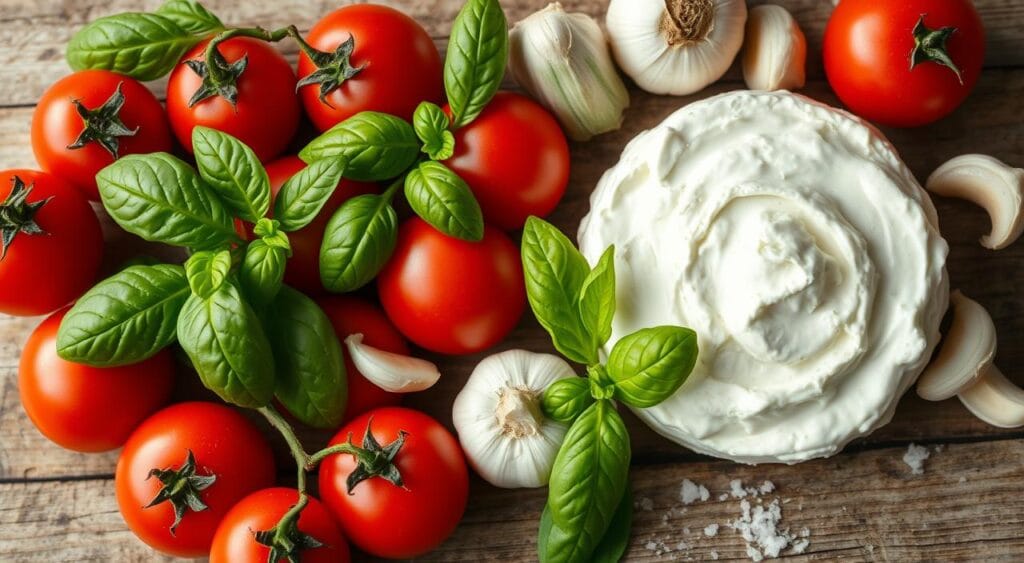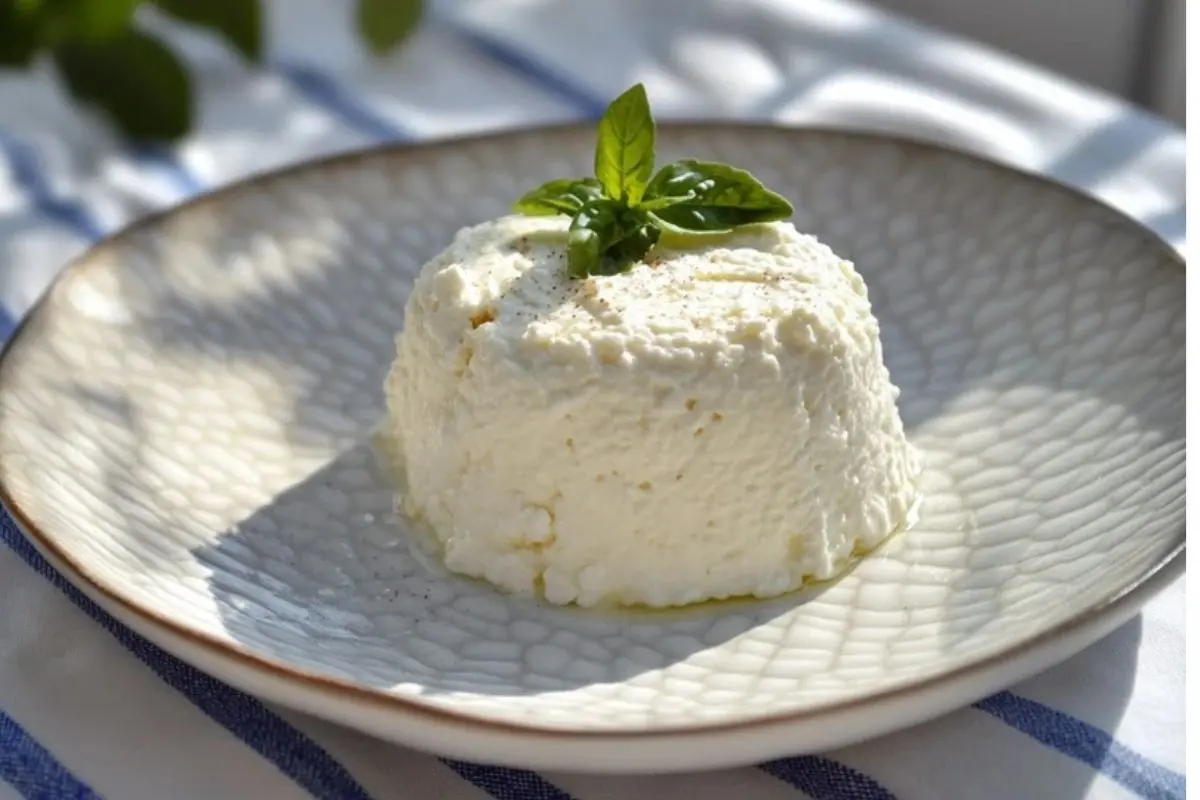Ricotta is a creamy Italian cheese loved for its soft texture and mild taste. It’s a key ingredient in lasagna, cannoli, and ravioli. It’s also great for sweet treats like cheesecake. Its versatility and gentle flavor make ricotta a favorite globally.
Key Takeaways
- Ricotta is a high-protein, low-fat cheese that’s rich in calcium and probiotics.
- Originating in ancient Rome, ricotta has been a staple in Italian cuisine for centuries.
- Ricotta is a versatile ingredient used in both savory and sweet dishes, from lasagna to cannoli.
- Compared to other cheeses, ricotta is relatively low in fat, making it a healthier choice.
- Ricotta contains essential vitamins and minerals, including A, B12, riboflavin, phosphorus, and zinc.
Ingredients for Creamy Ricotta Dishes
The main ingredient in ricotta dishes is the fresh, creamy ricotta cheese. It’s made from whey, leftover from making other cheeses like mozzarella. Choose high-quality, full-fat ricotta for the best taste. You’ll also need milk, vanilla extract, and sugar.
Ricotta and Substitutes
You can use whole milk or low-fat milk, depending on what you like. Vanilla extract adds a rich flavor, and sugar balances out the ricotta’s tang. If fresh ricotta is hard to find, try cottage cheese or mascarpone as substitutes.
Nutritional Benefits of Ricotta
Ricotta is tasty and good for you. It’s high in protein and calcium, which is great for bones. Its creamy texture makes it perfect for both sweet and savory dishes. It’s mild, so it goes well with many ingredients.

“Ricotta is not only delicious, but also quite nutritious. As a whey-based cheese, it is an excellent source of high-quality protein.”
Most creamy ricotta recipes use pasta, showing its popularity. Spinach is often paired with ricotta, making dishes creamy and nutritious. This combo is a hit with those looking for tasty and healthy options.
Recipes use different pasta shapes, like shells and lasagna noodles. This shows ricotta’s versatility in pasta dishes. Some recipes also mix ricotta with mozzarella and Parmesan, creating rich, flavorful meals.
Essential Tools for Ricotta Recipes
Making tasty ricotta dishes needs a few key tools. A good blender or food processor is crucial for mixing the ricotta, milk, vanilla, and sugar. You’ll also need mixing bowls and spoons or spatulas to mix everything well.
For more complex recipes like cannoli or ravioli, a piping bag is essential. It helps fill pastries easily. You might also need a baking sheet or casserole dish for baking your dish.
Optional Tools for Improved Results
Some extra tools can make your ricotta recipes even better. A stand mixer with a paddle can whip the mixture, making it lighter and fluffier. A small ice cream scoop or melon baller is great for portioning ricotta fillings.
For baked ricotta dishes, a kitchen torch can caramelize the top. This adds a nice touch to your creations.
Having these tools in your kitchen will help you become a ricotta master. They ensure your dishes have smooth bases, perfect fillings, and caramelized tops. The right tools can truly elevate your ricotta recipes.
Step-by-Step Instructions for Ricotta Recipes
Making homemade ricotta cheese is easy and gives better taste than store-bought. Just follow a few simple steps and pay attention to details. Let’s explore how to make delicious ricotta recipes step by step.
Blending the Ricotta Base
Most ricotta recipes start with blending the ricotta with milk, vanilla, and sugar. This step makes the mixture smooth and well-mixed. Be careful not to overmix, as it can make the ricotta too thick. Scrape down the blender or food processor to mix everything evenly.
Incorporating Additional Ingredients
After preparing the ricotta base, the next steps depend on the recipe. For cheesecakes or cannoli, chill the ricotta mixture before using. For lasagna or ravioli, mix it with eggs, herbs, or cheese. Gently fold the ricotta to keep it light and fluffy.
“The homemade ricotta cheese has a creamy texture and mild flavor that enhances various dishes, such as pizzas, cheesecakes, and mixed with yogurt.”
Professional Tips for Perfect Ricotta Dishes
Professional chefs have some secrets for making ricotta dishes amazing. One key tip is to drain the ricotta well before using it. Just put it in a fine-mesh strainer or cheesecloth-lined colander for 15-30 minutes. This step removes extra moisture, preventing a watery or gritty texture in your ricotta recipes.
Taste and Adjust Flavors
Another great cooking tip is to taste the ricotta mixture before you assemble or bake it. This ensures the flavors are just right. You can adjust the sugar or vanilla to get the perfect sweet-savory mix. For a creamier texture, whip the ricotta with a hand or stand mixer. This adds air, making it light and fluffy.
Stabilize the Texture
Some chefs’ secrets include adding a bit of cornstarch or flour to the ricotta. This helps keep the texture stable, especially when it’s used as a baking filling. Don’t be afraid to try new gourmet tips and flavors. Adding lemon zest, orange liqueur, or espresso powder can take your ricotta recipes to the next level.
“Ricotta is a blank canvas, waiting to be transformed into countless delicious creations. With a little know-how, home cooks can achieve professional-level results in their own kitchens.”
Serving, Storage, and Reheating Ricotta Dishes
Ricotta-based dishes are perfect for many serving ideas. For desserts like ricotta cheesecake or cannoli cream, serve in small bowls. Top with fresh fruit, nuts, or honey. For savory dishes, like lasagna or stuffed shells, ricotta adds a creamy touch.
Leftover ricotta can be stored in an airtight container in the fridge for up to 5 days. When reheating, do it slowly to keep the texture smooth. Warm it over low heat or in the oven at a low temperature.
| Serving Suggestions | Storage | Reheating Tips |
|---|---|---|
|
|
|
Follow these tips for serving, storing, and reheating ricotta recipes. This way, your ricotta dishes will always be delicious and creamy.
Health and Flavor Benefits of Ricotta
Ricotta cheese is not just versatile; it’s also packed with health and flavor benefits. It’s a great source of protein, calcium, and other essential nutrients. A half-cup of whole milk ricotta has 204 calories, 14.2 grams of fat, and 10.1 grams of protein.
Its mild, slightly sweet taste makes it perfect for both sweet and savory dishes. It adds a creamy texture to baked goods, fillings, and sauces. For those watching their calories or fat, lower-fat or part-skim ricotta varieties are available.
Ricotta is a “complete protein,” meaning it has all the essential amino acids. It’s also rich in selenium, an antioxidant that fights oxidative stress. Plus, it has lower lactose content than other dairy, making it good for those with lactose intolerance.
Ricotta’s nutritional profile and versatility make it a great addition to a balanced diet. It offers both health and culinary benefits.
Ricotta Recipe Variations and Substitutions
Traditional Italian ricotta recipes are tasty, but you can make them your own. Try using lighter ricotta options like part-skim or low-fat. Add unique flavors like citrus zest, chopped nuts, or spices to the mix.
Regional and Dietary Adaptations
Some recipes use sheep’s milk ricotta for a Mediterranean twist. You can also swap ricotta with cottage cheese or mascarpone in some dishes. For vegan or dairy-free diets, silken or firm tofu works well as a ricotta substitute in dishes like lasagna.
Ingredient Substitutions
- Greek yogurt can replace ricotta, using 3/4 cup of Greek yogurt for each cup of ricotta.
- Cottage cheese adds protein and a chunky texture, making it a great ricotta substitute.
- Cream cheese is creamy and smooth, perfect for rich frostings and adding flavor.
- Sour cream has a tangy taste and can be used sparingly as a ricotta substitute.
- Crème Fraiche is less tangy than sour cream and works well in sauces or desserts.
- Mascarpone is great for desserts like cheesecake or tiramisu, adding sweetness and creaminess.
Discover new flavors by trying recipe variations and ingredient substitutions with ricotta cheese.
Common Mistakes and How to Avoid Them
Making the perfect ricotta recipes is a fun cooking journey, but it comes with its own set of challenges. As someone who loves recipe tips, I want to share common mistakes and how to avoid them. This way, you can make visual guides and delicious dishes every time.
Avoiding a Dense, Gritty Texture
One big issue with ricotta recipes is over-mixing. This can make the texture dense and gritty, ruining the creamy smoothness you want. To avoid this, mix the ricotta gently with other ingredients. Stop mixing once everything is just combined, without overdoing it.
Preventing Watery Ricotta
Watery ricotta is another problem, caused by not draining the cheese enough. Letting the ricotta sit in a strainer for 15-30 minutes before using it helps. This way, you’ll get the right consistency for your recipe tips.
For a detailed guide on how to prepare ricotta and follow recipe techniques, check out our visual guides tutorial. With these tips, you’ll make cooking mistakes free and perfect ricotta recipes every time.
Complementary Dishes and Drinks for Ricotta
Ricotta cheese is incredibly versatile. It can be used in both sweet and savory dishes. This makes it a great addition to many recipes, from cheesecakes to lasagnas. There are many flavors and drinks that can enhance your ricotta-based dishes.
For desserts, ricotta cheesecake or cannoli go well with fruity white wines or sparkling rosés. The creamy ricotta and the wine’s fruitiness make a perfect match. For something richer, try a bold red wine with your ricotta desserts.
Savory dishes like lasagna or stuffed shells pair well with fresh salads and warm bread. The crunchy greens and warm bread contrast nicely with the creamy ricotta. A robust red wine complements the bold flavors of these dishes.
Appetizers like whipped ricotta with roasted vegetables or baked ricotta with parmesan and herbs are great with Italian meats, olives, and wine. The salty meats and briny olives balance out the creamy ricotta.
There are endless ways to pair ricotta with dishes and drinks. Experiment with different flavors and textures to find the best match for your ricotta creations.
Versatile ricotta pairs beautifully with a wide range of dishes and drinks, from sweet desserts to savory main courses.
The Origins and History of Ricotta Cheese
Ricotta is a classic Italian cheese with a long history. The name “ricotta” means “recooked” in Italian. This refers to the process of reheating whey left over from making other cheeses. This old method created ricotta, a soft, fresh cheese loved in Italian cooking.
Ricotta’s history goes back to the Bronze Age in Italy. It has been a key part of Italy’s food culture for many years. Its versatility and mild taste make it a favorite in many dishes, from cannoli to lasagna.
Over time, ricotta has changed and adapted in different regions. Varieties like ricotta di bufala campana and ricotta romana have special status in the European Union. Today, ricotta is enjoyed all over the world, with versions in the U.S. and France. It remains a cherished ingredient in Italian food traditions, whether in sweet or savory dishes.

